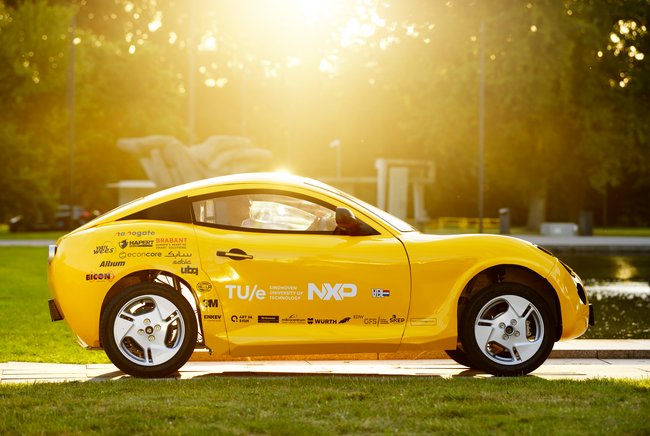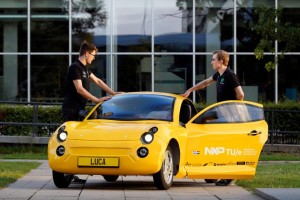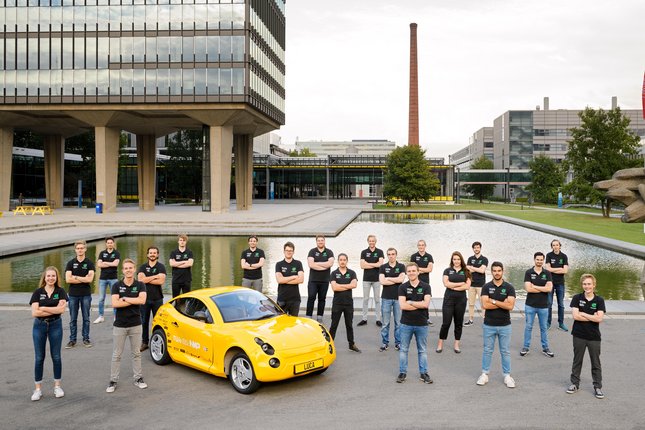
We collectively produce 2.1 billion tons of waste per year – that is to say, the PSV football stadium filled 7380 times to the roof. In order to demonstrate that you can reuse this waste in a useful manner, our TU/ecomotive student team presents a car made almost entirely out of waste. The result is a sporty-looking electric car called Luca with a base of flax and recycled plastic, a large part of which was even fished out of the ocean. The body, finish, windows and interior are also made of recycled materials, including PET bottles, the hard plastic ABS and household waste. Today, the car was officially unveiled today by André Kuipers.
Light and efficient
Luca is a compact car with two electric motors in the rear wheels. It can reach a top speed of 90 kilometers per hour and has an action radius of 220 kilometers. The consumption can be converted to about 180 kilometers per liter of gasoline. In addition to the efficient engines, this is due to the low weight: the car weighs only 360 kg without batteries. This is over half as light as comparable cars. In addition, the car only needs sixty kilos of batteries as opposed to hundreds of kilos for other electric cars.

Plastic from the ocean
Luca’s chassis consists of a unique sandwich panel developed by the students in collaboration with several companies. The exterior is made of flax fibers combined with plastic which was fished from the ocean. Although this was often in the ocean for several years and consists of different types of plastic, it is able to give the chassis sufficient strength when combined with the natural fibers. The core of the material is made of recycled PET bottles. PET can be recycled no more than ten times, so its lifespan can be greatly extended by using it in a car. After all, ten cars last longer than ten plastic bottles.
The residues are also included
However, the implementation of waste doesn’t stop there. The car’s body, for example, is made of recycled ABS, a hard plastic used in many consumer products such as toys, televisions and kitchen products. The car gets its yellow color from a wrap – a colored film – instead of paint. This film can also be removed without leaving any residue. This leaves pure plastic and makes the final recycling process a lot easier. The side and rear windows are also made of recycled material. The recycling process immediately gives the windows a luxurious black tint, so sustainability can be anything but boring.
A lot of waste has also been used in the interior. For example, Luca has two very comfortable custom-made chairs, the cushions of which consist of a combination of coconut hair and horsehair. The fabric around them is made of recycled PET but feels and looks like suede. The center console consists, among other things, of a plastic additive from household waste. In addition, there are even residual materials from Luca’s own production process: small pieces of flax with the plastic from the ocean are compressed into stylish, useful plates.
Circular economy
Altogether, this forms the sporty, sustainable Luca. “With this car, we want to show that waste is a valuable material, even in complex applications like a car,” says team member Matthijs van Wijk. Through this, the team hopes to make people aware of their consumption behavior and thus contribute to the development of a circular economy.

Contact
Barry van der Meer
(Science Information Officer)
Phone: +31 40 247 4061
E-Mail: b.v.d.meer@tue.nl
Source
Technical University of Eindhoven, press release, 2020-10-08.
Supplier
Technische Universiteit Eindhoven
Share
Renewable Carbon News – Daily Newsletter
Subscribe to our daily email newsletter – the world's leading newsletter on renewable materials and chemicals










